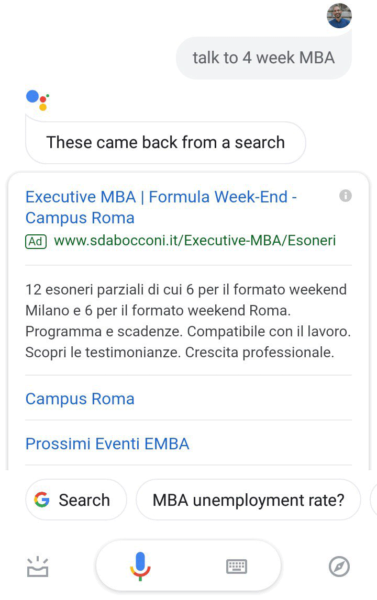Google isn’t concerned about making ad revenue from Google Assistant and Google Home right now. The company is more focused on gaining market share than ad revenue for the moment. Nonetheless, it’s starting to insert paid-search ads into Assistant results on Android smartphones; it’s also starting to monetize Google Home “traffic” as well – though, more tentatively.
Ads in Assistant results. In February, Google started testing ads in Assistant results on the phone. Then in early April, Google officially introduced ads in situations where there are web search results (vs. answers): “When relevant, these results may include the existing ads that you’d see on Search today.” The difference for the time being is fewer ads in Assistant results than general search.

Audio ads on YouTube Music. Last week Google also decided to give Google Home smart speaker owners access to the free version of YouTube Music, which is ad-supported. The premium version without ads is $9.99 per month.
One way to look at this is as a competitive response to free Amazon Music on Alexa devices. However, it’s also a way to upsell Google Home users to the premium version or, alternatively, generate ad revenue. The ad-supported version of YouTube Music is currently available on Google Home or other Google Assistant-powered smart speakers in North America, Western Europe, Japan and Australia.
Revenue from transactions. Two years ago, Google suggested it would monetize Google Home and the Assistant through fees tied to transactions. This was chiefly going to happen through Google Express ordering. However Google Express has struggled to gain momentum and recently lost Walmart as a customer, although it still has more than 1,000 retailers on its site.
Google Pay is another way the company could make money from Google Assistant or Google Home transactions. It currently doesn’t charge merchant fees; however, might change over time.
Local services ads. Google is exposing a subset of local listings in response to queries for local service providers on Google Home and Google Assistant. There are currently no ads returned for these queries. However, merchants must be certified through the Google Guarantee program (previously only available with Local Services Ads) or via Google partners Porch or HomeAdvisor.
While there are currently no ads in these local listings, it would be easy for Google to start charging a fee for a Google Guarantee certification or include Local Services Advertisers with a “sponsored” disclaimer to alert users they were advertisers (or both).
Google smart displays. Google is reportedly renaming its smart display “Google Nest Hub” and going to release a larger-screen version. It would be easy for Google to include sponsored search or display ads on the screen. In some ways, this is the model that would be least disruptive to users. This is not currently happening, but marketers should anticipate some form of on-screen advertising on Google smart displays in the relatively near future.
One analyst estimated that Google had sold more than 50 million Home Hub smart displays globally and 43 million in the U.S. Google’s smart display also appears to be one smart speaker category in which it’s outselling rival Amazon Echo.
Other types of ads. Roughly two years ago, Google appeared to run an audio ad for Disney’s live action film Beauty and the Beast, which was triggered by users asking about their daily schedules (“what does my day look like?”). Google denied that it was an ad, but it appeared to be a test of some sort of partner promotion. No similar promotions have appeared since that time.
Along these lines, there are some high-profile Google Home placements that might command a premium from brand advertisers if Google were to make them available. Again, this is hypothetical but one can envision selected ad placements on Google Home that would reach a large, TV-sized audience.
Why we should care. If we accept that Google Home’s market share is only 25 percent of the smart speaker market, in the U.S. that’s still 25+ million devices. When you include the Assistant on smartphones, the number of devices jumps to more than a billion globally.
As the recent inclusion of ads in Assistant results on Android phones indicates, Google does intend to generate ad revenue from the Assistant and Google Home. In addition to the actual and hypothetical ideas above, there are probably other options not listed. However, marketers should expect Google to test and introduce more advertising options for Assistant-powered devices by next year at the latest.